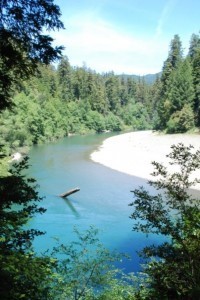Lisa Niver's Blog: We Said Go Travel, page 479
August 4, 2013
America: Independence on the Interstate
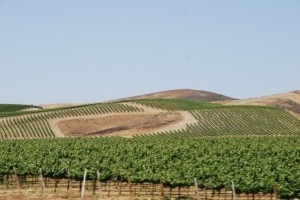 I have no fear of flying. I just don’t love it. I find it disorienting to board a plane in one city and land in another, having missed all the landscape and all the people in between. Give me a roadtrip in America any day.
I have no fear of flying. I just don’t love it. I find it disorienting to board a plane in one city and land in another, having missed all the landscape and all the people in between. Give me a roadtrip in America any day.
When I made the decision to move from Portland, Oregon to attend college in Claremont, California (40 miles east of L.A.), I knew I wouldn’t make that move on an airplane. Each year of college, I made the drive south at the end of summer, and north again at the end of spring. Sometimes these migrations were short, other times I dragged them on for weeks, but each time I got in the car and turned onto the on-ramp for Interstate-5 I felt my soul buoyed by the fact that I could go anywhere.
The end of the journey was always where I planned to end up; I never had a drastic moment of change where I decided to abandon school and work a bookstore in Texas instead. I was and still am happy with the two homes I’ve created for myself on the west coast.
In between these two points on the map were myriads to explore, and I did, usually with the company of a close friend or family member. We would stray off I-5 to take the highways 1 or 101 for a stretch and then return to the fast moving freeway cutting through swaths of agricultural land. Sunset Bay State Park, Oregon. Ashland, Oregon. Mount Shasta City, California. Humboldt Redwoods State, California. Each of these places we would stop, and when we left I would feel as if a bit of the unknown had become known, a new familiar place for me to return on my next migration.
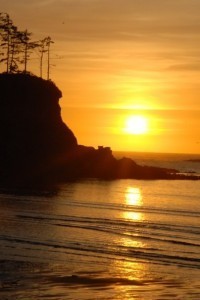 Each place we filled with memories of our own. Swimming in the cold Eel River off the Avenue of the Giants. Watching the California state capitol building lit up for the night in Sacramento. Driving hours out of our way simply for ice cream sundaes at Fenton’s Creamery in Oakland. Stopping in Santa Cruz for a gypsy punk concert, and then continuing tired and drenched in sweat later that night. Listening to the birdcalls that in the dead of night make me imagine too vividly the predators of Jurassic Park. Making the final push through the grapevine as temperatures and altitude both climb. Upon leaving each place, whether it was a picturesque rest stop, a secluded camp ground, or a travel channel featured restaurant, had burrowed into my heart and come with me.
Each place we filled with memories of our own. Swimming in the cold Eel River off the Avenue of the Giants. Watching the California state capitol building lit up for the night in Sacramento. Driving hours out of our way simply for ice cream sundaes at Fenton’s Creamery in Oakland. Stopping in Santa Cruz for a gypsy punk concert, and then continuing tired and drenched in sweat later that night. Listening to the birdcalls that in the dead of night make me imagine too vividly the predators of Jurassic Park. Making the final push through the grapevine as temperatures and altitude both climb. Upon leaving each place, whether it was a picturesque rest stop, a secluded camp ground, or a travel channel featured restaurant, had burrowed into my heart and come with me.
When I go back to Portland for Christmas, winter storms and snow make the passes in the Siskiyou Mountains temperamental and occasionally dangerous, so I fly. Invasive body pat-downs, waiting areas filled with stressed and weary passengers, the cries of toddlers as their ears pop all set my own nerves on edge. My spine tingles with the general discomfort of the mode of travel we’ve all chosen for its convenience.
The summers, though. I eagerly anticipated the sight of Castle Crags and each familiar off-ramp and detour. The 14 hours of driving (if you do it all at once along the 5), never gives me that unsettled feeling of powerless waiting I am overwhelmed with at the airport. When you drive it, every turn is in your control. On the interstate and state highways and scenic detours I no longer feel like I am waiting to arrive home—the whole route is home now, and each return is with pleasure.
About the Author: Ariel Bloomer is just returning to the States after a year of teaching English in Bulgaria. In the future, she hopes to write novels, work with university students, and drive the Ring Road in Iceland. You can read about her travels in the Balkans and her upcoming battle with reverse culture shock at the Unintential Explorer.
The post America: Independence on the Interstate appeared first on We Said Go Travel.
Social sharing: How Facebook got me travelling
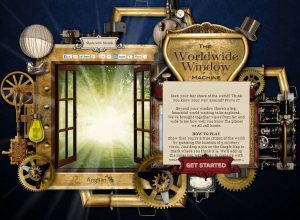 Social sharing: How Facebook got me travelling
Social sharing: How Facebook got me travelling
First it was the advent of the internet and then it was the sudden explosion of social media that made the world in which we live a much smaller place. On the whole, it’s technology that’s enhanced all of our lives – as well as inspiring me to stop viewing it on the web and to explore it with my own eyes!
After graduating from university and settling into a full time job, I began noticing through Facebook that a lot of my friends had chosen to go InterRailing across Europe. A couple had gone backpacking across Australia, while a group of lads I used to share a Sunday afternoon drink with had made the bold decision to explore South America for six months.
Having been brought up on a diet of caravan holidays around the UK with my parents – which is no bad thing, by the way – I didn’t think I was missing out on much when all these travel plans were in the pipeline.
Time to travel
But a few months into my new shirt-and-tie office life, I began to grow jealous of what I was seeing on my Facebook feed. Pictures of statues, monuments and landmarks were accompanied by people I recognised and knew, stood together, in their t-shirts and shorts, looking almighty tanned and proud of themselves. It looked like fun – much more fun than work.
So that was it – I ditched the job and began planning to see more of the world. It felt incredibly liberating to know that I could go literally anywhere. I wrote down all the places I thought about visiting – some I’d seen on TV, others I’d seen on Facebook. And then I set about visiting them.
The Blue Lagoon, Iceland
In the middle of absolutely nowhere, as if it was dropped from a great height into the eerily black volcanic landscape of Iceland, is a geothermal pool full of minerals that are said to hold special healing powers. It was the outrageously stark contrast of the deep blue, steaming pool set against the backdrop of the black yet snow-topped mountains that initially drew me to it.
Victoria Falls, Zimbabwe
Known locally as ‘the smoke that thunders’, Victoria Falls is twice the height of Niagara Falls. I had an uncle who lived in Montreal, who used to tell me that if I were to see any waterfall in the world it should be the one he’s never been to. He had seen Niagara while my friends had visited the Iguazu Falls on the border of Argentina and Brazil. Between us it feels like we’ve now completed the set!
The High Tatras, Slovakia
I had a relation who’d spent time living in Bratislava and he recommended that I explore the High Tatras in northern Slovakia – which is what I did. They’re part of the Carpathian mountain range, which makes it a popular place to ski in winter. However, with its glacial lakes and an electric tram service, which connects the resorts and offers spectacular views, it’s equally as popular in the summer.
Kutná Hora, Czech Republic
One of the most fascinating places I visited was the Sedlec Ossuary – known as the ‘bone church’ because its chapel is decorated with the bones of more than 40,000 skeletons. Technically it’s art – macabre art, it must be said – but it’s unlike anything else. The focal furnishing is the chandelier, which is said to hold every single bone in the human body.
I’d also spent time in Italy, Romania, Spain and Cyprus, with Japan and Thailand next on my list.
Testing my travel knowledge
Just recently I found this great travel game on the net, called the worldwide window machine, which almost felt like it was purposely made for me! You’re presented with an image from Google Maps, taken somewhere in the world, and you have to call on your knowledge to know where it is, and then drop a pin on the map. The closer you are, the better you score.
Since everything is scored, it’s highly addictive. I’ve constantly been trying to beat my own record – and now that I’ve shared it with a few friends on Facebook it’s become ultra competitive. The only problem is that it’s giving me more ideas of where I’d like to visit!
My ambition was to see more of the world – and after two years of travelling (not to mention a few credit cards worn to a nubbin) I felt I did just that. But now I’ve got a new list – although they include far flung locations that may have to wait for a time when my bank account is properly replenished!
About the Author: Cameron Thomas was born in Lincoln, UK, and studied marketing and communications at the University of Huddersfield. He’s an avid photographer and has been working for a major food retailer since he returned from his travels across southern Africa and central Europe.
The post Social sharing: How Facebook got me travelling appeared first on We Said Go Travel.
Basque Country: Home is where the Pueblo is
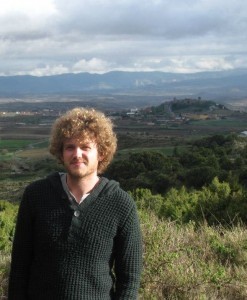 It was exactly what I had in mind when I applied to teach in the Basque Country; green hills, a strange language, separatist protests, and retired shepherds stalking down cobble stone streets that had seen bull and beret alike- this was a strange region in a foreign land, and I was ready for it. My assigned town, called Laguardia (“the guardian”) in Spanish, Biasteri in Basque, was at first wild glance the sublime realization of that which I had for months pictured in mind; this, I told myself, was where I would be Hemingway, be me, be a man; a man on a mountain, the best kind of man. Nothing to do but read, write, teach, and drink down sunsets like gazpacho on a Spanish summer day. It wasn’t freedom that I felt-not yet, anyways-but independence, and to a 23-year old aspiring writer set on spurning law school, SUVs, and Sunday brunch, independence felt great.
It was exactly what I had in mind when I applied to teach in the Basque Country; green hills, a strange language, separatist protests, and retired shepherds stalking down cobble stone streets that had seen bull and beret alike- this was a strange region in a foreign land, and I was ready for it. My assigned town, called Laguardia (“the guardian”) in Spanish, Biasteri in Basque, was at first wild glance the sublime realization of that which I had for months pictured in mind; this, I told myself, was where I would be Hemingway, be me, be a man; a man on a mountain, the best kind of man. Nothing to do but read, write, teach, and drink down sunsets like gazpacho on a Spanish summer day. It wasn’t freedom that I felt-not yet, anyways-but independence, and to a 23-year old aspiring writer set on spurning law school, SUVs, and Sunday brunch, independence felt great.
Then reality hit, and to my giddy, ready senses, it looked like this: a medieval village, perched upon an ornery lump of earth above the high Riojan wine country; the Basque Rioja called the “Alavesa.” Its thick, reconstructed flanks straddled the hill; the walls drew the landscape in, and vineyard vistas lapped at its stone shores. Inside the fortress’ facade, narrow streets wound like the wind that swept through them; high, cold, mighty. Tourists followed them, taking pictures and drinking wine, waiting for the sunset that seemingly always came; came softly, slowly, floating achingly along the valley of La Rioja like a painter’s wet canvas until at long lens’ last the colors suddenly disappeared, and the town, startled, awoke from its sunburnt siesta–thirsting for the Tempranillo that filled more than just its bodegas and their patrons, but indeed its soul itself, one starving for an identity lost long ago, as I’d soon learn.
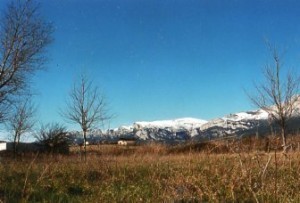 Ironic, in retrospect, that I’d come here, of all geopolitical regions, to seek out my independence; this was the paradox of my journey. “ESTE NO ES ESPAÑA” read the graffiti, and I in turn read it everywhere; on every street, this slogan; on every wall, this resistance; on every street, this sign-THIS IS NOT SPAIN. It was cruel, this contradiction; what was my independence, my new found freedom, in the daily light of this struggle? What did it matter, really? My walks, my Dylan, my Kerouac, my ruck sack; these items, idols, activities, all were at once symbols of what I had gained and what the Basques, frankly, might never have.
Ironic, in retrospect, that I’d come here, of all geopolitical regions, to seek out my independence; this was the paradox of my journey. “ESTE NO ES ESPAÑA” read the graffiti, and I in turn read it everywhere; on every street, this slogan; on every wall, this resistance; on every street, this sign-THIS IS NOT SPAIN. It was cruel, this contradiction; what was my independence, my new found freedom, in the daily light of this struggle? What did it matter, really? My walks, my Dylan, my Kerouac, my ruck sack; these items, idols, activities, all were at once symbols of what I had gained and what the Basques, frankly, might never have.
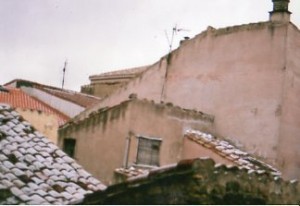 I wasn’t a rolling stone in the hills of the Basque Country anymore. No, I had hit a wall; the wall of Laguardia. I began to gather moss, and it looked like this: a boy, not the man as planned, struggling to understand his adopted home; an outsider, torn between cultures, languages, peoples; Basque at the dinner table, Spanish in the classroom. I, unlike my friends, only spoke the latter. Their language, Euskera, was their identity; I was deaf to Euskera, blind to the Basque Country. I no longer felt independent but isolated, and the difference depressed me. I began to drift away from my friends, from the Basques.
I wasn’t a rolling stone in the hills of the Basque Country anymore. No, I had hit a wall; the wall of Laguardia. I began to gather moss, and it looked like this: a boy, not the man as planned, struggling to understand his adopted home; an outsider, torn between cultures, languages, peoples; Basque at the dinner table, Spanish in the classroom. I, unlike my friends, only spoke the latter. Their language, Euskera, was their identity; I was deaf to Euskera, blind to the Basque Country. I no longer felt independent but isolated, and the difference depressed me. I began to drift away from my friends, from the Basques.
It was then, however, in my isolation, that I began to understand my home, Laguardia, and what we had in common. The town was stuck; stuck in this cultural chasm, between Basque identity and Spanish life. I could relate. The village was a border town, and always had been. It didn’t understand itself any better than I did. Neither Spanish nor Basque, the village was like me: a misfit, and a wine-drunk one at that.
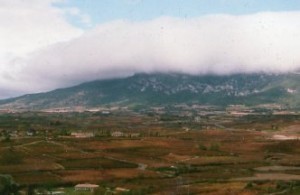 Laguardia’s roots were dug deep in the lands and histories of Iberia; of Navarre, the Basque Kingdom, and of Castile. I stopped trying to dig them out, and what I found, inexplicably; was freedom; a peace with what I was in this place, an outsider, and with the town I had come to call my own. I finally felt at home in the Basque Country, and that, more than independence, was everything.
Laguardia’s roots were dug deep in the lands and histories of Iberia; of Navarre, the Basque Kingdom, and of Castile. I stopped trying to dig them out, and what I found, inexplicably; was freedom; a peace with what I was in this place, an outsider, and with the town I had come to call my own. I finally felt at home in the Basque Country, and that, more than independence, was everything.
About the Author: Joseph Farewell is a young writer from California. He’s lived in Spain, France, and the Basque Country in between. When he’s not running from bulls, studying psychology, or hitchhiking in Scotland, you can find him on Facebook.
The post Basque Country: Home is where the Pueblo is appeared first on We Said Go Travel.
August 3, 2013
Kerala, India: The Place that Makes Me Feel Free
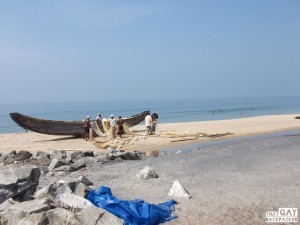 The more I travel, the more I realise that my feelings about somewhere do not only come into being because of that ‘place’. My feelings about the cities, towns, beaches, and villages where I end up on my journeys are shaped by the locations I visited immediately beforehand, by the anticipation of the places that I will travel to afterwards, as well as my current feelings about work, relationships, and family.
The more I travel, the more I realise that my feelings about somewhere do not only come into being because of that ‘place’. My feelings about the cities, towns, beaches, and villages where I end up on my journeys are shaped by the locations I visited immediately beforehand, by the anticipation of the places that I will travel to afterwards, as well as my current feelings about work, relationships, and family.
A place, a time, and my wandering thoughts all converge to give me a true sense of somewhere. I’m sure there are many who have mastered the art of living in the present far more effectively than me, but I have a wandering mind and that means I tend to live in the past, present and future all at once.
This way of being doesn’t seem very conducive to finding a sense of ‘freedom’, and though I can live in an apparently freer way than most, my passport providing me with the luxury of being able to visit pretty much everywhere around the globe, and my ability to work on the road offering endless travel opportunities, would I say that I feel free? Perhaps not.
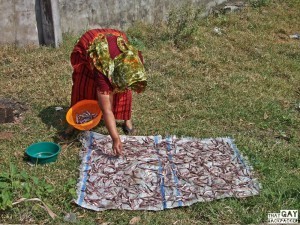 But there is one place on this earth that inspired a greater sense of freedom in me than I have ever felt before – the state of Kerala in south India. In fact, there was one point on my trip, as I was strolling along the waterfront of Odayam, a stunning coastal fishing town, when the thought crept up on me that I had never felt so relaxed before in my whole life. Relaxation doesn’t necessarily equal freedom for everyone, but for me and my jittery mind, I had never experienced that kind of escape before – the kind of slowing down of your mind that somehow also focuses it and provides you with a greater clarity about the things in your life that suddenly seem unimportant and unworthy of clouding your brain.
But there is one place on this earth that inspired a greater sense of freedom in me than I have ever felt before – the state of Kerala in south India. In fact, there was one point on my trip, as I was strolling along the waterfront of Odayam, a stunning coastal fishing town, when the thought crept up on me that I had never felt so relaxed before in my whole life. Relaxation doesn’t necessarily equal freedom for everyone, but for me and my jittery mind, I had never experienced that kind of escape before – the kind of slowing down of your mind that somehow also focuses it and provides you with a greater clarity about the things in your life that suddenly seem unimportant and unworthy of clouding your brain.
So what is it about this tiny state in south India, which so many people like to tell me is “not the real India”, that made me feel such a sense of freedom where other destinations have failed?
Kerala provided a convergence of all of my favourite things about travel with very little of the rubbish stuff. By rubbish stuff I mean dorm rooms and hippies, both of which put me on edge. The culture of homestays in Kerala allowed me to experience a little bit of family life, a home away from home with freshly cooked family meals and dinner table chat, and I’m guessing that the ukulele touting hippies were somewhere in “the real India”, wherever that might be. This laid the foundation for a month long visit to the state of Kerala where there is a truly staggering breadth of landscape.
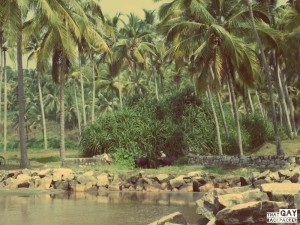 The beaches of Varkala are an ideal spot for beach bums who can choose to have relaxed days of swimming and massages and fun nights of partying should they wish, the port town of Cochin has an incredible café culture and the smell of ginger and cardamom are always present on the streets, the backwaters promise unforgettable boat trips amongst the endless green of the waterways, and the hill stations provide ample opportunity for trekking and learning about life in the coffee and tea plantations.
The beaches of Varkala are an ideal spot for beach bums who can choose to have relaxed days of swimming and massages and fun nights of partying should they wish, the port town of Cochin has an incredible café culture and the smell of ginger and cardamom are always present on the streets, the backwaters promise unforgettable boat trips amongst the endless green of the waterways, and the hill stations provide ample opportunity for trekking and learning about life in the coffee and tea plantations.
Beyond the beauty of Kerala, it is the kindness and openness of Keralan people that focused my newly relaxed mind on wanting to be a better person. In Kerala, it is impossible to walk down the street without locals trying to make conversation with you, to openly smile at you, to offer you a cup of masala chai – and always simply because that’s the nice thing to do, because kindness is so important to the people there.
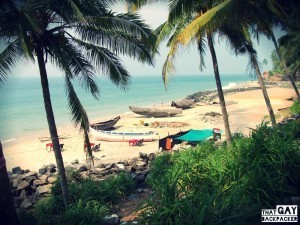 Kerala is not somewhere in India that has a great deal of poverty, but people aren’t rich either, and the population’s feeling of contentedness that derives from living in the moment and putting your best food forward is something that rubbed off on me, gave me a sense of freedom, and when the pressures of life start to weigh heavy, I remind myself of that feeling and what inspired it – the heart filling kindness of the people who live in the most beautiful place I ever visited, Kerala.
Kerala is not somewhere in India that has a great deal of poverty, but people aren’t rich either, and the population’s feeling of contentedness that derives from living in the moment and putting your best food forward is something that rubbed off on me, gave me a sense of freedom, and when the pressures of life start to weigh heavy, I remind myself of that feeling and what inspired it – the heart filling kindness of the people who live in the most beautiful place I ever visited, Kerala.
About the Author: David is a twenty-something travelling writer from London, documenting his travel experiences at ThatGayBackpacker.
The post Kerala, India: The Place that Makes Me Feel Free appeared first on We Said Go Travel.
Myanmar: Ferry Mothers
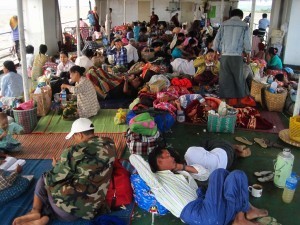 A sinewy arm reached for my backpack, picking it up as if it were a feather. He smiled and waved for me to follow. Agile and muscled, he ran across the plank and waited. I carefully placed my steps, watching the brown water of the Irrawaddy flow below me. I squeezed through doors, up stairs and wove through men doubled over, loading and unloading heavy bundles. Finally he stopped and pointed; the deck of the boat was covered in what looked like tiny parking spaces and this spot was mine. He set my backpack down, smiled, and was gone.
A sinewy arm reached for my backpack, picking it up as if it were a feather. He smiled and waved for me to follow. Agile and muscled, he ran across the plank and waited. I carefully placed my steps, watching the brown water of the Irrawaddy flow below me. I squeezed through doors, up stairs and wove through men doubled over, loading and unloading heavy bundles. Finally he stopped and pointed; the deck of the boat was covered in what looked like tiny parking spaces and this spot was mine. He set my backpack down, smiled, and was gone.
I took in my surroundings. A hundred or so people covered the deck: laying, sleeping, eating, coddling babies, or reading. Boxes, bags, clothes, food, and blankets filled in any other available space. I squeezed into my spot like a slightly bent puzzle piece.
At dusk the engine began a low, guttural mutter. The ferry pushed away and the town’s stupa became smaller and smaller; the sunset igniting like a fire in the sky. It didn’t take long for the hum of the engine and the sound of rushing water to woo me into sleep.
I awoke to the sound of the motor tiring; the ferry was stuck on a small sandbank. The engine revved and pushed but to no avail. I sat up to breathe in the morning when a woman with gentle lines around her eyes and thanaka carefully brushed on her cheeks, came up to me. She smiled and pointed to my backpack, pointed to me, pointed to a space on the other side, and pointed at herself.
I settled in a small space between her and an older woman with a weathered tattoo on her chest and betel nut stains in the corners of her mouth. I watched as she carefully selected the best leaf, painting it with slaked lime before dusting it with tobacco and areca nut. She rolled it tightly before slipping it into the side of her mouth, smiling with burgundy-tinged teeth when she noticed me watching. Taking turns raising their eyebrows and pointing at various foods they brought with them, they offered me anything and everything they had. We huddled around our sleeping mats, a temporary mismatching family coming together to share food. I had just met them but for the next few days I would soak up the familial warmth like a homesick sponge.
After sharing dinner together, the woman with gentle lines patted my pillow and smiled, it was time to sleep. She offered her blanket, her pillow, trying again to give everything she had. But I couldn’t sleep. I kept thinking of everyone I’d met along the way.
The Burmese English teacher and now friend, who told me 15 years ago if he had spoken to a tourist, he and everyone he knew would be investigated by the police. The Palong man who had once fought for freedom in the tea-clad hills of eastern Burma and whose brother still refuses to give up. The Burmese girl who had made it into Thailand, was adopted, but can’t go to school because she has no birth certificate, no records of who she is. But the people of Burma are the definition of resilient.
Burma’s history is littered with violent repression, forced labor camps, hushed genocide, censorship, and the unwarranted jailing of thousands of protesters for years upon years. Despite the corrupt government that reigned more than 40 years, the people of Burma consistently fought back, refusing to fall silent. The freedoms available today were not handed out; they were fought for with blood and impenetrable hope. But if ignorant of their past, you would never know. They smile like they’ve never frowned. They give as though they have too much. The women beside me, my “ferry mothers”, are perfect examples.
The engine let out a sigh and finally grew silent; we sat drifting but stuck at the same time. Still my mind wouldn’t settle.
I feel free here; free to let down my barriers, free to trust in people, my shoulders only weighed down by my backpack. But I can’t help but think, is it wrong to feel so free in a country where many freedoms are so new? Where many still fight? That so many of us take for granted what others fight their entire life for?
The women beside me fall into a steady sleep, their breathing almost resembling the rhythm of the water. The river’s liquid lullaby finally starts to take effect. Nearing an unconscious state, my mind falls into a pothole stuck on this thought: for many, freedom is not a right but a hard-fought privilege. Don’t forget that. Appreciate. Don’t forget. Appreciate. Do what you can to change that and don’t ever, ever let yourself forget.
About the Author: Jillian Gotfredson: I grew up in Kansas City, Missouri and have had the privilege of exploring Argentina, Peru, Ecuador, Colombia, Chile, Belize, Guatemala, El Salvador, Honduras, Nicaragua, Costa Rica, Panama, the Philippines, Borneo, Malaysia, Thailand, Laos, Cambodia and Burma (Myanmar). I’m currently on a working holiday visa in Australia to fund my next adventure.
The post Myanmar: Ferry Mothers appeared first on We Said Go Travel.
Cambodia: Lost and Found in Ratanakiri
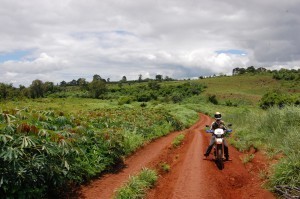 I had been trapped penniless in Phnom Penh for over a month. It had been ten weeks since I was conned out of five hundred dollars by a bank in Malaysia.
I had been trapped penniless in Phnom Penh for over a month. It had been ten weeks since I was conned out of five hundred dollars by a bank in Malaysia.
Seven weeks since my beloved and irreplaceable journal, my glasses, wallet, iPod, all of my bank cards, and most of my money was stolen from the beach on Koh Phi Phi.
Five weeks since the last of the cash I had secretly squirreled away was taken, unbeknownst to me, from the bottom of a bus in Bangkok as I fled to a friend in Cambodia. Accustomed to laughing off such calamities in the dizzying dance of infinite carelessness I have called my life, something was different this time. I felt bereft of more than just things when I arrived in that corporeal city with nothing but a dollar fifty left to my name and the sweet savior who was willing to take me in for nothing in return. It felt like I was giving up .
From my first day in the busy capital city I was an apparition. The smile on my face a pale shadow of the one that used to stretch through every limb as I discovered a new part of the world. As it was, Barbara and I explored the sweaty streets, she an easy distraction from the precarious sorrow that burrowed itself quietly inside. Knowing all along that one last card would topple my shaky tower I took careful care to keep it standing. My breath was ever baited, afraid to blow it all down. But when the laptop with every word I had written since I left inexplicably died, I was helpless to stop the tumble. For the first time in a long time, I gave up, and gave in to the tears that had been waiting for their turn to fall.
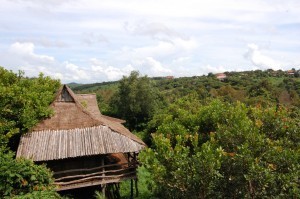 I knew I needed to leave this city, to find the piece of me that had been lost along with everything else. My only thought was to abandon the motos swarming shrill in the streets as they dangerously whipped past, the stench of sewage hanging ever in the air like some sepulchral fog, the grime of a city that never seems to wash off, to leave it all behind. The moment my Western Union transfer came through, I found my way to Ratanakiri.
I knew I needed to leave this city, to find the piece of me that had been lost along with everything else. My only thought was to abandon the motos swarming shrill in the streets as they dangerously whipped past, the stench of sewage hanging ever in the air like some sepulchral fog, the grime of a city that never seems to wash off, to leave it all behind. The moment my Western Union transfer came through, I found my way to Ratanakiri.
As the crowded mini-bus jostled its way along the gutted red clay roads into the heart of the quiet province, hope sat perched in my chest for what was to come. I somehow knew this place would be my remedy. Within moments of my feet touching the soil in Ban Lung, a young moto driver whose face beamed with warmth and welcome took me to a guest house sitting hidden in the tree tops amongst the mountainous terrain. The quiet terrace of the lodge overlooked the vigorously green hills, lush in vegetation and untouched save for a sprinkling of red roofs hinting at their presence beneath the trees.
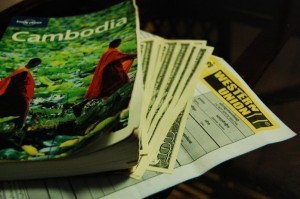 I spent my first day in the rare, sweet silence of my own thoughts. It was my first time in Asia when there wasn’t a party pulsing heady into the night, a hundred backpackers to meet, a bus to miss, another to catch, there wasn’t anything at all.
I spent my first day in the rare, sweet silence of my own thoughts. It was my first time in Asia when there wasn’t a party pulsing heady into the night, a hundred backpackers to meet, a bus to miss, another to catch, there wasn’t anything at all.
But when I was ready to find adventure, it was ready for me too. Riding an elephant with that warm boy, deep into a jungle littered with forgotten waterfalls, trodding over less than beaten paths. Swimming each day in a volcanic lake until sunset, talking to strangers or not as I pleased.
Pushing through the vibrant volcanic clay roads on the back of a stranger’s motorcycle, tracing like scars through the verdant countryside, rich in every way imaginable. We crashed three times but I didn’t care. I laughed the laugh of a woman who knows something you don’t and smiled without boundaries. I kissed a stranger and never said goodbye. I simultaneously existed completely within myself and yet somehow belonged to this province, this place. It was everything I thought Cambodia would be but hadn’t yet seen.
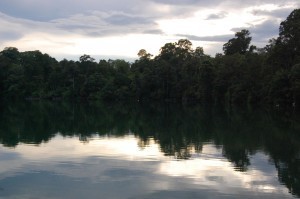 In just one day my bruised and withered soul effloresced into the woman I had been before and more. Nothing I had lost mattered now, because this place offered everything I could ever need. And once you realize that the things you need aren’t ever actually things, that is when you know you’re truly free.
In just one day my bruised and withered soul effloresced into the woman I had been before and more. Nothing I had lost mattered now, because this place offered everything I could ever need. And once you realize that the things you need aren’t ever actually things, that is when you know you’re truly free.
About the Author: Taylor Ahlstrom is a ceaseless wanderer, seasoned heartbreaker, and aspiring raconteur. She currently has no idea what she is doing with her life other than living it. You can read more about her adventures at WanderLustLogs.
The post Cambodia: Lost and Found in Ratanakiri appeared first on We Said Go Travel.
Gloaming in the Mountains of West Virginia
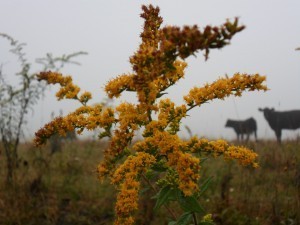 I was a speck on the vast stretch of land sweeping out around me. Tall grasses undulated across the flats and up the hills before seeming to spill back down the other side. Clouds, purple streaks clinging to the last color of the sun’s light, whisked across the darkening sky. In every direction mountainous peaks shot up, exposing their grassy sides to the waves of winds tumbling from the gaping sky above. Sheep dotted some fields, white masses in the distance. I could imagine their lips nibbling daintily while their ears flickered and eyes spun around, slightly perturbed by the nighttime shadow descending upon them. Below my perch on the bouldered cave-top, slick black cows and calves buried their heads in the golden grass along the creek. Intermittent soft ‘lows’ were carried along the gusts as cows relocated their vagrant calves.
I was a speck on the vast stretch of land sweeping out around me. Tall grasses undulated across the flats and up the hills before seeming to spill back down the other side. Clouds, purple streaks clinging to the last color of the sun’s light, whisked across the darkening sky. In every direction mountainous peaks shot up, exposing their grassy sides to the waves of winds tumbling from the gaping sky above. Sheep dotted some fields, white masses in the distance. I could imagine their lips nibbling daintily while their ears flickered and eyes spun around, slightly perturbed by the nighttime shadow descending upon them. Below my perch on the bouldered cave-top, slick black cows and calves buried their heads in the golden grass along the creek. Intermittent soft ‘lows’ were carried along the gusts as cows relocated their vagrant calves.
My eyes followed the single dirt road to where the forest cropped out, obscuring the view to camp. In this quickly fading twilight, I knew I had to head back soon. The generator would be started by now in the bunk house, and people would be sitting at the ramshackle table, legs kicked out and cowboy hats dangling on the backs of chairs. The hounds, exhausted from running alongside our horses all day, would be half-heartedly playing, grabbing each other’s throats with guttural growls while maintaining a horizontal sprawl on the plywood floor. I slid from my seat and began to pick my way down the steep bank to the road. Goosebumps rose on my arms as cool draughts swept away the heat rising from the sun-soaked earth.
The pure enormity of nature around me compelled me to be quiet. I placed each foot carefully, silently, so I could almost feel that I had disappeared into this raw West Virginia wilderness. A soft moo hummed from the cow nearest to me. Her eyes rose accusingly and I realized I had crossed directly between her and her calf. Her calf was oblivious, chewing curiously on a purple thistle bud. The cow swung her hindquarters away, standing square to face me. Her liquid eyes met mine and she held the gaze, her head lowering and tilting threateningly. A sharp snuff burst from her nostrils. I froze momentarily. A furious debate began in my head: walk or run? New enough to cow/calf pairs to not know the right move to make but experienced enough to be wary of a cow’s maternal instinct, I wished I was in shouting distance of camp.
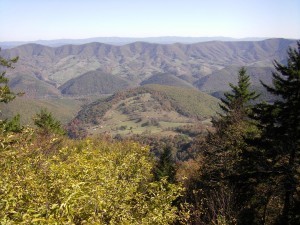 I eased forward, singing softly the last James Taylor song that had been playing in the truck on the way up the mountains. “Oh, I’ve seen fire and I’ve seen rain. I’ve seen sunny days that I thought would never end. I’ve seen lonely times when I could not find a friend….” My words slipped away. The cow’s hard stare remained on my figure inching by. She gave another warning huff. This exhalation caught the attention of her calf. It swung its head around. Startled by its distance from its mother, it quickly turned and trotted back towards her, giving me a wide birth and a nervous sideways kick as it passed. The cow instantly dropped her nose to her calf’s back. Her eyes lingered on me a half second more before she turned and herded her baby away to safer grazing.
I eased forward, singing softly the last James Taylor song that had been playing in the truck on the way up the mountains. “Oh, I’ve seen fire and I’ve seen rain. I’ve seen sunny days that I thought would never end. I’ve seen lonely times when I could not find a friend….” My words slipped away. The cow’s hard stare remained on my figure inching by. She gave another warning huff. This exhalation caught the attention of her calf. It swung its head around. Startled by its distance from its mother, it quickly turned and trotted back towards her, giving me a wide birth and a nervous sideways kick as it passed. The cow instantly dropped her nose to her calf’s back. Her eyes lingered on me a half second more before she turned and herded her baby away to safer grazing.
I watched my path more closely until I was clear of the herd. Stars were emerging in the canvas of night overhead. The wind stirred the grasses and trees and the creek chirped and plinked downstream. I paused a short distance from the bunkhouse. Silhouettes crossed by the door. The light glowing from the doorway was met with a wall of darkness. On this side of the wall, the blackness was actually a thousand shades of color. The earth was as alive as ever, pulsing as it did every day, whether I was here to see it or not. It was my complete inconsequentiality, my being a temporary filling of space, that made me feel transparent. It was as if my skin of human consciousness molted away and left my soul free to shiver in the swirling air enveloping me. I listened to one more coyote howl then, like a calf returning to its mother, I crossed into the light and the wash of familiar voices.
About the Author: Amelia Greenberg was raised in New Hampshire and is a nineteen-year-old undergraduate at Grinnell College in Iowa. She has been riding horses since she was nine and has worked the past four summers on a horse and cattle farm in Virginia. She has also worked on horse farms in Wales and France.
The post Gloaming in the Mountains of West Virginia appeared first on We Said Go Travel.
August 2, 2013
Malaysia: First Visit to Kuala Lumpur
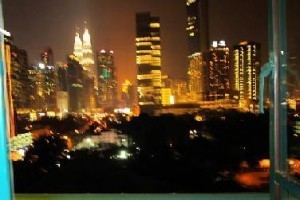 The Air Asia Flight from Kolkata, India to Kuala Lumpur,Malaysia was comfortable and uneventful As this flight took of late it got dark and nothing was visible outside. After flying for approximately three and half hours I suddenly saw a vast area of dazzling lights amidst the pitch-black surroundings. From about twenty thousand feet high up in the sky, Kuala Lumpur seemed so enticing, bedecked in rows and rows of glittering diamonds. Even before landing I had fallen in love with the Malaysian capital.
The Air Asia Flight from Kolkata, India to Kuala Lumpur,Malaysia was comfortable and uneventful As this flight took of late it got dark and nothing was visible outside. After flying for approximately three and half hours I suddenly saw a vast area of dazzling lights amidst the pitch-black surroundings. From about twenty thousand feet high up in the sky, Kuala Lumpur seemed so enticing, bedecked in rows and rows of glittering diamonds. Even before landing I had fallen in love with the Malaysian capital.
After clearing Immigration and Customs, we stepped out with our bags & baggage. There were three eager faces waiting for us in the arrival area. The youngest of the three looked very sleepy. As soon as I hugged him he was wide-awake & back to his ‘Spiderman’ antics. Since it was past midnight Malaysian time, we quickly piled into the car and sped towards our destination, my daughter’s house in Jalan Ampang, a good eighty kilometres from the airport at Shah Alam. The roads being excellent, our journey didn’t take us long.
The first sight that greeted me on entering her house was the well – lit twin Petronas Towers, visible from the wide French windows. What a mesmerizing sight that was! We could see the twin towers standing tall in their full glory, lit from head to toe in beautiful glimmering lights. I hadn’t ever imagined that on the first night itself I would be seeing these iconic towers and that too from such close quarters. After waking up it was the same glorious sight again, only this time sans lights they looked mellowed but still very impressive with the steel structure gleaming in the sunlight.
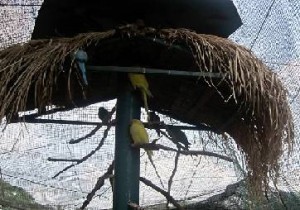 After a hearty breakfast we set out to explore the city. Kuala Lumpur had a very sanitized look and feel. The roads and pavements were scrupulously clean with nothing littered on either. The local populace seemed a little shy and liked to keep to themselves but by no means were they unfriendly. In fact they were the non-boisterous and quiet type.
After a hearty breakfast we set out to explore the city. Kuala Lumpur had a very sanitized look and feel. The roads and pavements were scrupulously clean with nothing littered on either. The local populace seemed a little shy and liked to keep to themselves but by no means were they unfriendly. In fact they were the non-boisterous and quiet type.
We decided to visit the Batu caves first. Smooth wide roads lined by tropical rain-forests on both sides proved soothing to our eyes and our nerves. I could drive on for hours along these silky roads taking in the clean air and getting seeped in the green vista of the tall trees with their broad canopies. On reaching our destination we saw huge caves of stalactites and stalagmites perched on top of a hill. Climbing up the two hundred something steps was quite tiring but refreshing all the same. On reaching the top we found ourselves in the main cave with an Indian deity being worshipped there. This was a novel experience.
We then set out for the bird park. The whole area is covered by wire meshing right to the top of the trees, so the birds have the freedom of flying short distances. There were very colourful macaws, cute little budgerigars, owls that looked very sleepy, storks on stilt like long legs frantically trying to filter out fish and worms with their beaks, a couple of peacocks showing off their florescent plumes, huge ostriches, and pelicans with their beaks filled with fish. One big pelican managed to scare ‘Spiderman’, our grandson, by trying to snatch his ice cream. We tried to shoo him away but he just wouldn’t budge. It was quite a long trek around the park, so by the time we finished we were all very hungry. We trooped in to the cafeteria where we had a delicious meal of Thai green curry with sticky and fragrant jasmine rice,.
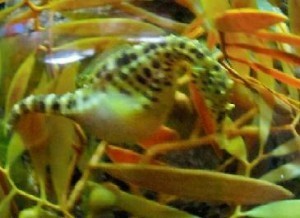 On our way back we went to the KL Aquaria. There were all varieties of fish – small fish, large fish, rotund fish, slim fish, black ugly fish, very pretty fish of many different hues- and there were large turtles. as well as some snakes and cute little sea horses. In one section we had to go through a fiber glass tunnel and there were huge ray fish and sharks swimming all around us . We clicked a lot of pictures in our attempt at immortalizing these captive creatures
On our way back we went to the KL Aquaria. There were all varieties of fish – small fish, large fish, rotund fish, slim fish, black ugly fish, very pretty fish of many different hues- and there were large turtles. as well as some snakes and cute little sea horses. In one section we had to go through a fiber glass tunnel and there were huge ray fish and sharks swimming all around us . We clicked a lot of pictures in our attempt at immortalizing these captive creatures
Next day the weather was cool and the prospect of going out without having to face the oppressive heat was very appealing…our destination was Putrajaya, the administrative capital of Malaysia. We drove through silky roads, this time lined with oil-palm plantations. These trees looked more like dwarfed date palms and added a different sort of charm to the roads. Putrajaya was very beautiful…lovely houses with manicured gardens, wonderful parks and a very beautiful pink mosque right on the riverbank. Across the river were seven bridges, each a replica of a world famous bridge. After clicking several pictures for posterity we decided to call it a day and headed for home.
About the Author: Onku Ghosh: I am a home-maker.I am interested in writing poems, painting, cooking, and gardening. I am also interested in net-surfing. Find her on Facebook.
The post Malaysia: First Visit to Kuala Lumpur appeared first on We Said Go Travel.
Israel: Dig
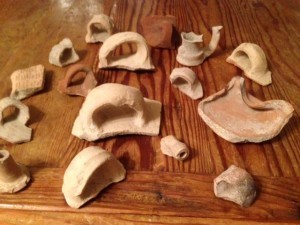 I belong to a family of preachers and teachers—all workaholics–but inside people. My strength is in my willpower and verbal skills, not my physical abilities. Joining the City of David archeological excavation in Jerusalem, Israel, after my junior year of college was completely out of character. Keith, my boyfriend, a recent history graduate and a three season Intramural champion, relished the thought of a hands-on history project.
I belong to a family of preachers and teachers—all workaholics–but inside people. My strength is in my willpower and verbal skills, not my physical abilities. Joining the City of David archeological excavation in Jerusalem, Israel, after my junior year of college was completely out of character. Keith, my boyfriend, a recent history graduate and a three season Intramural champion, relished the thought of a hands-on history project.
During the descent into Tel Aviv, I asked him “how do you say ‘where is the bathroom?’”
“I don’t know.”
“How do you say ‘do you speak English?’”
“I don’t know.”
“What do you know?”
“I know my Haphtorah.”
“You told me you spoke Hebrew.”
“I do, my Haphtorah”
“How is chanting about Moses going to help us with anything?”
“Don’t worry, everyone speaks English.”
I wondered ‘isn’t it arrogant for Americans to assume everyone speaks English?’ Secretly, I hoped it was true.
Arriving in the heat of Tel Aviv pale and exhausted, the large soldier with a machine gun hanging from his shoulder, glaring at me as I exited the airplane, was a virtual punch in the stomach. On the bus ride from the airport, the passenger in front of me mentioned that this was the line terrorists bombed the previous week. The grandmother in the seat across from me handed me fruit and told me I needed to eat more. The soldiers standing in the aisle kept bumping the muzzle of their guns against my knee.
On the first day of the dig, standing on a covered patio with dozens of students–big students who clearly played outdoor sports–I started to tremble. The walk to arrive at the dig in the 5:30AM heat was enough for me. Then the approach to the work site undid me. It required climbing down an ancient wall of stacked white stones the size of footballs and then up a small promontory of rocks held together with eroding dirt. That first morning, I couldn’t do it. Fear that I didn’t have the strength or the balance or whatever it is that people need to climb ancient walls paralyzed me. While my group went on, I worked alone on the easily accessible top layer breaking up dirt with a pick ax.
Each day on the dig was hard, dust-encased work. But, before the first week was out I was crawling all over the site, the fear of climbing lost. I fell into a routine: up at 5AM, devour the cup of instant oatmeal, and then ride the bus to the city gates. Daily I practiced the only Hebrew word I truly needed, “rega” meaning “wait,” as our group ran towards the bus just as the driver closed the doors. The only other people on the bus were the soldiers I checked for each day before feeling safe enough to doze through the ride. It was the walk from the bus stop, around the Old City walls, and to the dig site that pulled me out of bed each day.
At dawn, the sun turned the grey majestic City walls a warm pink, a breath-taking transformation. As the hue of the stones warmed, so did the temperature. During this silent walk I fell in love with Jerusalem. Too early for the child vendors yelling “CokeCokeCokeCoke,” or the blaring horns from cars choking the ancient streets, I thought about the people whose footsteps I walked in: rabbis, Christ and his apostles, Mohammad. More than the Church of the Sepulcher, the Western Wall, or the Dome of the Rock, this daily metamorphosis from dull to brilliance, from cool to warm, felt holy.
I finished the dig stronger, more confident, and a beautiful shade of bronze. For the first time in my life, I was physically challenged and I dug deep and met the mark. On the last day, after the speeches and goodbyes, Keith gave me discarded broken pottery handles, a pipe and an oil lamp, all thousands of years old. These pieces sit in our living room, more precious than the presents we exchanged on our wedding day. In times of illness, death, terrible jobs, worry over our children, I see them and remember, I can survive hard things.
About the Author: Kim Allen-Niesen is in an ‘inbetween stage.’ She is in between being a lawyer and something else. She is pursuing her three passions, writing, art history, and spiritual direction, and looking forward to seeing where they lead her.
(I discovered this evening that the pictures I took in 1984 of the dig are in slides (who uses slides!?!), so I could submit additional pictures if desired, I just need to get the slides made into pictures which will take longer than the July 4th deadline.)
The post Israel: Dig appeared first on We Said Go Travel.
Negara, Bali – Land of exiles and daughters
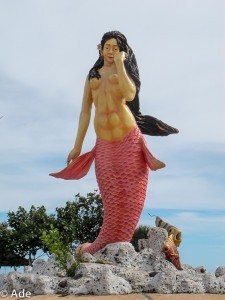 An obscure village of 200,000 on the west coast of Bali, Negara is where my father was born. It is a country of fertile paddies that climb hills in elegant, terraced steps and spread out seemingly forever until they kiss the sea.
An obscure village of 200,000 on the west coast of Bali, Negara is where my father was born. It is a country of fertile paddies that climb hills in elegant, terraced steps and spread out seemingly forever until they kiss the sea.
I had only heard its name mentioned a handful of times. In idle chatter, my father would let slip his dream of living in the Balinese countryside, spending afternoons watching the rice grass sway, listening to song of crickets and the trickle of surrounding creeks.
My father valued freedom in the big things and small: he eschewed desk jobs and office attire, as well as organized tours with prescribed timetables. He believed freedom was not material, but spiritual. Family legend has it that at one point he wanted to take to the open seas and become a sailor, but his greatest aspiration was to go to that great bastion of freedom: America. He succeeded.
When I decided to spend a year living in Indonesia, I resolved to visit Negara. I pictured the stylish rice fields of Ubud – a center of Balinese royal palaces and the artistic heartland of the island’s modern-day tourism – with its luxury villas, charming boutiques and yoga retreats.
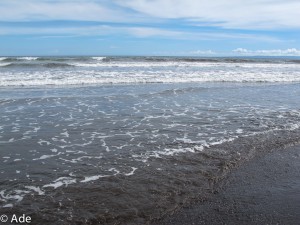 The real Negara offers far less stimuli – no galleries, no industry to speak of, not even a movie theater. I stay with relatives who live above the general store they own on the main road connecting Bali’s provincial capital, Denpasar, and the port of Gilimanuk, the mouth of the sea route to Java. I sleep near the large sacks of cloves, their potent, dizzying scent greeting me each morning. Across the street, beside the auto shop my great-uncle started, is the home where my grandfather was born. Apart from its recent aquamarine paintjob, the house still retains its colonial-era features and resilient teak furniture.
The real Negara offers far less stimuli – no galleries, no industry to speak of, not even a movie theater. I stay with relatives who live above the general store they own on the main road connecting Bali’s provincial capital, Denpasar, and the port of Gilimanuk, the mouth of the sea route to Java. I sleep near the large sacks of cloves, their potent, dizzying scent greeting me each morning. Across the street, beside the auto shop my great-uncle started, is the home where my grandfather was born. Apart from its recent aquamarine paintjob, the house still retains its colonial-era features and resilient teak furniture.
The days warm up quickly in Negara, but life is slow. Mornings are passed visiting older relatives, rifling through their aged photos and cache of memories, filling in missing branches of the makeshift family tree I have sketched in my iPhone. Sometimes we visit my great-grandparents’ graves in the old Chinese cemetery. We shower flower petals – pink, purple, red – over the tombs to show our respect. For someone raised in the American suburbs these prosaic activities were otherworldly, magnificent in their simplicity, rich with meaning.
In the high heat of the afternoon, my cousins shut the store down and take me for a drive. First we stop at one of their two “gardens”. At first I pictured a manicured English lawn, bordered with pansies and decorative grasses. Instead, we drive up a narrow, unpaved road to a small lot where colorful fowl wander. From there we hike into a thickly wooded hillside. On either side of us are trees pregnant with fruit – chocolate, durian, rambutan, mangosteen, papaya, pomelo, among the dozen species available. A brown cow and her healthy calves roam freely on the hillside, feasting on grass, as does a family of long-eared goats. These visits always end with a drink from the garden’s enormous young coconuts – so massive they must be shared.
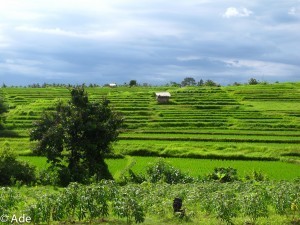 The area’s attractions include two beaches, Pantai Delod Brawah and Pantai Rambut Siwi. Unique to this stretch of coast is the ebony sand that lines the shore. Pantai Rambut Siwi plays host to a majestic Hindu temple perched on a cliff overlooking the glassy sea, while at Pantai Delod Brawah, a giant mermaid with salmon-colored scales greets us. She towers over us and her long black locks graze the sky. Her masculine body is rippled with muscles, but her gentle face betrays a deep sadness.
The area’s attractions include two beaches, Pantai Delod Brawah and Pantai Rambut Siwi. Unique to this stretch of coast is the ebony sand that lines the shore. Pantai Rambut Siwi plays host to a majestic Hindu temple perched on a cliff overlooking the glassy sea, while at Pantai Delod Brawah, a giant mermaid with salmon-colored scales greets us. She towers over us and her long black locks graze the sky. Her masculine body is rippled with muscles, but her gentle face betrays a deep sadness.
In traveling to Negara, and spending extended time in my ancestral home, I did not receive my father’s blessing. You are wasting your time, he reasoned. We came to America to embrace the future, yet you are trying to regress to the past. In my heart I respond that it was the traumatic events that drew us away from Bali, from Indonesia, that deserved his disdain, not this land of abundance; that the freedom of Negara was a dream that germinated in his heart.
Before the continents split and drifted apart, there was Pangea. This is Negara to me. Today our family has scattered to many corners of the globe, from British Columbia to Switzerland, from Los Angeles to Dubai, from Istanbul to Indiana, to pockets of Java. Negara remains. This verdant land that bursts with life and teems with ghost stories is at once exotic and homey. It is where I came from and where I can go, as a stranger and as a daughter, as exile and heir. My relatives fled Negara in pursuit of their freedom, and I came back looking for mine.
About the Author: Ade is a writer from Los Angeles living in Indonesia. More about her on her blog.
The post Negara, Bali – Land of exiles and daughters appeared first on We Said Go Travel.
We Said Go Travel
We Said Go Travel is a global community of over sixteen hundred writers with articles from every continent.
Stories are shared with photos and video from a perspective of the transformative power of travel. We Said Go Travel has hosted live and online events as well as travel writing contests around the world. ...more
- Lisa Niver's profile
- 57 followers


